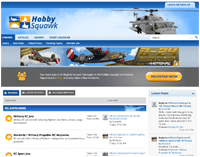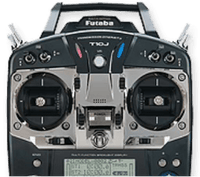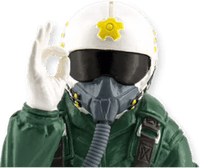Don't Like The Paint Scheme? How To Paint The New Livery You Want
von Todd BredaI am not a builder. Oh sure I can slap a Plug-N-Play together with the best of them but when it comes to any kind of significant build from a kit or ARF, I lack the tools, space, patience, mechanical and engineering prowess many folks display in this hobby.
One thing I do love to do is paint.
Not liking or even passing on a model simply because of the paint scheme has never been a problem for me. My dad fixed and painted cars for a living so I grew up loving to watch a car come into his shop beat up with an old worn out color, leave his shop looking factory new with a beautiful new paint job.
Through the years I've taken it upon myself to find liveries I prefer over the stock model and repaint them in that chosen livery. I have received a lot of compliments over the years for my work but I have to be honest here. I don't think it's a natural talent so much as it is just taking the time to do it. I really believe anyone can paint the scheme they want with the proper know-how.
Here's a before and after of my Freewing 90mm F/A-18E Hornet. The stock livery isn't bad looking at all, but I simply love the Blue Angels and their awesome livery. So I will walk you through how I did it step-by-step and in so doing understand that these same basic steps and methods apply to any new paint scheme.

Step One - Don't Be Afraid Of Paint
I think the reason so many won't paint is because they are afraid to mess their model up. At best, they think it will look terrible or at worse, eat the foam of their model. With a little knowledge you can avoid both.
Step Two - Learn What Paints To Use and Which Paints To Avoid
While this topic can get plenty in-depth (and I encourage you to research this topic online...The more knowledge you have the better) for simplicity sake I will cover the basics. Let me be clear. I am not saying these are the best methods. I do not profess to know everything there is to know about painting RC model airplanes but these methods have worked for me time-and-time again with pleasing results.
I have painted all of my planes over the years using enamel spray cans. Whether it's Testor's or something from Home Depot or Lowe's. Doesn't enamel eat foam you say? The simple answer is it can but only if you're not doing it right. And learning how to do it right is simple which I will show you in one of the following steps.
The paint that you want to avoid on any foam model and one that will gladly devour said foam model with reckless abandon is lacquer.
While enamel can be used on foam if applied correctly, lacquer eats foam for breakfast, lunch and dinner.
Step Three - Gather Your Materials and Begin The Prepping Process
Let's assume that you have chosen the paint for your model, you will then need the following tools and materials:
- Painter's Tape - I prefer professional grade painter's blue tape. You can find these rolls in any hardware store. This is how you mask off the portions of the plane you want to paint and the portions you don't.
- Newspaper or Paper Towels - I use paper towels personally but newspaper works fine as well. This allows you to cover large sections of the model you don't want any paint adhering to.
- Hobby Knife (with fresh blade) - Any standard hobby knife with a fresh blade will work. This allows you to trim your painter's tape in areas that are curved (like the canopy) or for trim work if your paint scheme has multiple colors.
- Paint/Respirator Mask - Unless your painting booth/area is professionally ventilated (and even if it is) you need a paint mask to protect yourself from breathing in the paint fumes and particles. Home Depot has a good selection of respirators/masks. Be sure the mask you use is approved for airborne painting (like spraying).
- Water-Based Polyurethane - This will seal and protect your foam. Can be used both before and after painting the new scheme. I use Miniwax Water Based Polyurethane in a 11.5 oz. spray can.
- Light Spackle/Foam Filler - Using these can be a great way to get rid of any pre-existing dings or dents in your foam that you don't want showing through your new paint job. This is especially valuable if you are trying to make a beloved old model look new again.
- Sandpaper (80-120 Grit) - Grit varies depending on the job at hand but I have only ever needed to use between 80 and 120 grit.
- Primer - Once you have filled any dents and dings and sanded to a smooth finish you will want to spray your model with primer before applying the actual paint.
- Hobby Paintbrushes - I use these for detail work such as bleeds (the paint sometimes can bleed under the tape in certain spots, or over-spray, etc)
- Paint Thinner - To clean the brushes or if the paint gets on a surface you don't want like wheels or plastic parts, etc.
- Decals - Your new scheme will likely need decals, especially if you are going for a scale appearance or to match an existing scale livery. I always use Callie Graphics. She's been wonderful for me. Quality vinyl decals with great service. She does custom decals too without blinking an eye.
Step Four - The Prepping Process
Now that you have your paint, tools and materials together, it's time to prep your model. I begin by fixing any major dings or dents or damage to the foam by using either a light spackle or foam filler like Beacon's Foam-Tac Foam Filler. I apply the filler evenly and smoothly to the ding or dent using an old credit card or putty knife. Once the filler/spackle has dried completely and you have sanded it to a smooth finish it's time to move to the next phase.
This is where I wipe the model down completely using a smooth cloth (like an old but clean cotton t-shirt for example). You want to remove any dust or particles so they don't adhere to your model once you begin priming and painting.
Now it's time to mask the plane for painting. This is the most time-consuming task but it's one of the most important. You want to take your time applying the tape to your model to make sure your lines are clean and smooth. Make sure you apply the tape firmly. You want to avoid having the tape raise in spots as the spray can get underneath and create more work for you later (However, you don't want to press down too firmly either or the tape could peel away the paint on the surface you were trying to protect, especially if the foam is sensitive).
Use the paper towels or newspaper with your tape to mask off any parts of your model you don't want primer or paint on. Once your model is completely masked off to your liking, it's time to get out the rattle can.
Step Five - Prime and/or Paint
Important! The first thing you want to do in this step is make sure you have adequate ventilation, space and a respirator mask that protects you from breathing in the airborne paint particles and fumes.
A little confession here. I only prime my nicer, higher-end models. In fact, most of my paint jobs entailed me painting directly over the stock paint finish and even stock decals. That's my lazy side, and quite frankly most the time the paint job ended up looking great any ways. However, if you are all about the fine details, and doing things properly, especially if it's an expensive or favorite model, you will want to remove any of the main stock decals (especially the ones that have a thickness to them you can feel when rubbing your fingers between the foam and edges of the decal) and prime the model.
Once you are ready to paint using the spray enamel of your choice, and you have shaken the can for a good minute or so to make sure the paint is mixed properly, the key to success (and your foam not becoming a meal for your paint!) is to apply LIGHT, EVEN COATS.
For your first coat the distance between your model's surface and your spray can should be at least 10-12 inches apart. Start spraying just beyond the model and once the spray is activated move your hand in an even, smooth motion across the surface. Avoid spraying in one place, always moving the can in even, broad strokes across the surface.
After your first coat, let the paint dry. Refer to the spray can's information for how quickly you can expect to paint your next coat. Some paints will say "Dries in 10 minutes". You can always check by lightly touching the painter's tape closest to the paint line.
If it feels dry, go ahead and apply your second coat. Continue this process until the paint has completely covered your model. Your latter coats can be applied a bit more liberally now that the base coats have sealed and protected the foam.
Step Six - Clean Up and Detail Work
Once the model is completely painted, let it dry for 24 hours before removing the tape and applying decals. Unless the Painting Gods have smiled down upon you, chances are there will be some touch up/detail work to do. You can help minimize this process by removing the tape slowly and with the pulled up tape portion pulled back closely to the tape surface. Not quite parallel but definitely not perpendicular from the surface. If anything split the difference.
This helps the tape pull away cleanly without pulling up paint or foam material. Once you have removed all of the tape/masking elements take a close look for any overspray/paint bleeds. This is where the hobby paintbrushes come in handy. Carefully apply the clean up paint to the locations needed. Another area that taking your time will pay big dividends in the final product.
If your livery involves a multiple trim scheme (like the Blue Angel has a blue base coat with yellow trim) simply apply the same steps above. Once the blue base coat was painted on and completely dried, I masked off the areas I wanted to be yellow and the areas I did not want yellow (the blue).
Finally, once again, once everything was completely dry, I applied the decals, stood back and approved of my "new" model!
So with some simple tools, a little time investment and know-how, anyone can paint the livery of their choice successfully.
To finalize, here are a few quick tips:
- Paint in warmer temperatures. Paint adheres, applies and dries much more smoothly and easier in warmer temperatures.
- Take your time. The more you take your time, the better the results.
- Clean your paint nozzle after each coat. Paint nozzles get clogged easily which can cause dripping and uneven spray. Use a paper towel to wipe off the excess paint from the nozzle after each coat to keep the nozzle opening clear and clean.
Happy Painting and as always Happy Landings!
Get the latest from Motion RC sale and product announcements
You can unsubscribe at any time!

Hobby Squawk Community Forum
visit forum
RC Knowledge Blog
visit blog
Guidance & advice for beginners
Find out more- Wenn du eine Auswahl auswählst, wird eine vollständige Seite aktualisiert.
- Drücke die die Leertaste und dann die Pfeiltasten, um eine Auswahl zu treffen.
